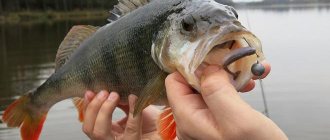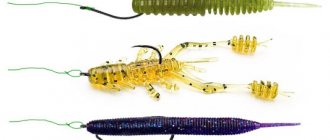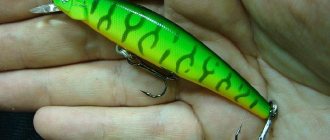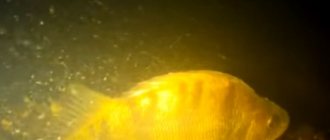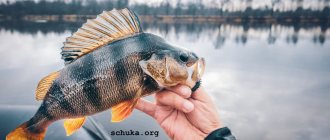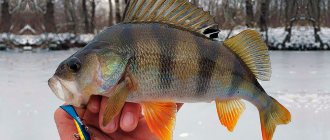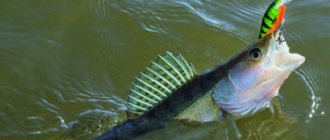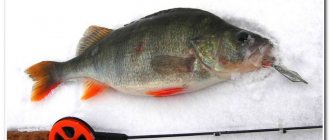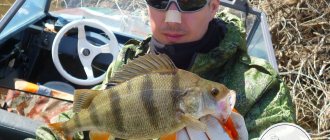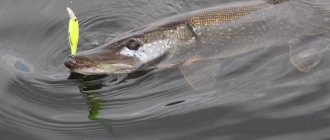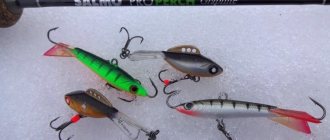Spinning fishing
02 February
Overview of perch fishing with spinning rods in spring (April, May)
Perch is found almost everywhere - in ponds, rivers, lakes, and even in the sea. But in the open sea they are not hunted so often. Fishermen enjoy catching freshwater species of the predator, which have a beautiful greenish color with black stripes. In spring, this fish becomes especially active and is well caught using spinning rods. However, for fishing to be successful, you need to know the places where the perch lives during this period, the habits of the minke whale, and be able to choose the right gear. What are the features of perch hunting in the spring?
Features of perch fishing in spring
Perch bites equally at any time of the year. It is very voracious, catches well in April and May, in the summer, but changes its location seasonally in search of places where food accumulates. The best spring results can be achieved in May, after the water has warmed up sufficiently. Before this, after the ice melts, the perch prefers to stay away in the depths, and after warming up it goes out to shallow water. Catch volumes are affected by:
- 1. High water. Spring floods make the water cloudy. The perch does not see the object of hunting and shows little activity. Fishermen need to wait for the water to clear or look for areas where it remains clear.
- 2. Spawning period. It falls at the end of April - beginning of May and takes only three days. The fish feeds even during spawning, but does not bite well.
Immediately after spawning, several days of frantic feeding begin, and fishing for perch with a spinning rod becomes incredibly exciting. In what period this robber spawns depends on the beginning of the decline of the water and on when it warms up to a temperature of 9ºC. The fish lays its eggs on the leaves of algae and waits for the water to recede so that they do not remain on the shore. In central Russia, spawning usually occurs when birch leaves bloom. The post-spawning feeding period of perch coincides with the period during which rosehip flowers fall off. Then the minke whale moves closer to its summer mooring sites and remains there until autumn.
Bait for spring perch
Bait for spring perch is no different from other times of the year. Since perch is a predator, it prefers to find the smell of blood in bait balls. Usually they try to scatter bait in shallow water, and when splashes appear, you should start fishing.
Recipe No. 1
- fish fillet – 150 g ;
- pork offal – 200 g ;
- bloodworm – 50 g ;
- flour – 150 g ;
- dried blood – 0.5 tbsp ;
- egg powder – 1 tbsp .
To prepare this bait, you need to chop the giblets, then finely chop the fillet, mix this mass with bloodworms, flour and egg powder. Then add dried blood, which can be purchased at a pet store.
These bait balls need to be thrown into the future fishing spot a few days before fishing. And when fishing, it is worth mixing river sand, which is familiar to fish, into the bait.
Recipe No. 2
The second recipe consists of the following ingredients:
- sawdust – 50 g ;
- powdered milk - 1 tbsp ;
- bloodworm – 50 g ;
- Daphnia – 50 g ;
- fish fillet – 150 g ;
- corn cake – 1 00 g .
Place fish fillets cut into 5 cm strips into a plastic container, add sawdust, milk powder, daphnia and bloodworms. Then mix the mixture with corn cake and add 1 tablespoon of honey to the balls with bait as a flavoring. Before fishing, add some river sand to the mixture.
Choosing a place for spring perch fishing
In cold water, the fish stay at depth; when it warms up, they move closer to the edge of the coast. You should look for perch in spring:
- - in pits;
- — on edges near river beds;
- - in the shallows;
- — at the boundaries between current and smooth water;
- - at the mouths of small rivers and streams;
- — on the edges of water thickets;
- — in the bays;
- — in coastal flooded bushes;
- - among tree branches lowered into the water.
Large specimens hide in snags, in holes and near pools located away from the main current. Small perch usually gather near the shore, feeding on the eggs of small fish. In search of food, it can enter floods and remain in them after the water subsides until another flood. After spawning, the fish continues to remain near its eggs, chasing the fry.
Which bait should you choose?
- Balance. As a rule, they choose a coloring similar to this predator. In addition to perch, pike also bite on this bait, so you need to have a small amount of balancer in stock. Using this bait, you first need to feel the bottom with it, make a sharp rise, and then lower it back into the water. After carrying out such manipulations 5 times, the perch will swim to the noise and will definitely taste the hook.
- Spoon. There are many varieties, and it is best to choose a spoon with a red tail. Of course, perch does not always bite on a spoon, but with its help you can definitely determine whether there is fish in this place, or whether you should look elsewhere.
- Jigs. The color of the jigs must be copper, and they should be baited with a worm, maggot or bloodworm. It happens that wiring is done without amplitudes, but with pauses. If the fish is not active, a reelless bait is suitable, which causes vibrations in the water, which sometimes attracts perch.
Gear selection
Freshwater bass are not very large, so fishing for them does not require heavy rods. If fishing occurs without long casts, forms with a length of 1.8 to 2.4 meters are suitable. If long casts are needed, models with a length of 2.4 to 3 meters are available. For jig fishing or at great depths, baits weighing 35-40 grams are used. In other cases, up to 20 grams of dough is enough. These could be the following rods:
- 1. Extreme Fishing Panache Obsession 742M all-rounder. Suitable for shore fishing and fishing from a boat. The blanks have a medium-fast action, are 2.2 meters long, and have a test range from 4 to 18 grams.
- 2. Models Craft Rizer RZS-702M, designed for jigging and jerking with various wobblers and poppers. The length of the rods is 2.1 meters, the test range is from 6 grams to 24 grams.
- 3. Norstream Spiker 832MH blanks with a decent power reserve and dough from 10 grams to 37 grams. They work effectively with different baits and allow you to catch perch in fast-flowing rivers and at depth.
For perch hunting in the spring, reels with dimensions from 1000 to 2000 Shimano are used. It is desirable that they be suitable for thin fishing line or braid, be equipped with small-capacity spools that allow you to do without backing, and have good traction. The number of slips will be reduced by monofilament line up to 0.2 millimeters thick, braided line up to 0.1 millimeters thick.
Spinning equipment and fishing methods
Fishing in the spring months is characterized by different fishing methods and equipment used. The main differences between spring fishing and summer fishing are the predator’s preference for small-sized baits. In addition, it is better to avoid surface baits such as poppers or walkers.
In March
For March fishing for perch, the following leash rigs are used:
- Carolina rig - consists of a bullet sinker moving freely along the braided main line, a stopper bead and a long leash made of monofilament or fluorocarbon fishing line with a tied silicone bait on an offset hook;
- Retractable leash is a leash rig consisting of a triple swivel, to which is attached a piece of fishing line with a pear-shaped or stick-shaped sinker, a leash made of monofilament or fluorocarbon fishing line with a cross-section of 0.18-0.20 mm with a small silicone bait attached to the end, mounted on an offset hook.
The length of the leash in these rigs ranges from 80 to 120-130 cm and depends on the activity of the predator. When the activity of the perch is low, it is increased to 100-120 cm, but if the perch greedily grabs the bait on almost every cast, it is reduced to 70-80 cm.
The weight of the sinker is selected taking into account the depth at the fishing site and the strength of the current:
- For shallow reservoirs with depths of no more than 3 meters, the rigs are equipped with weights weighing from 6 to 8 g.
- For medium depths and small currents, sinkers weighing 10-12 g are used;
- At great depths or strong currents, sinkers weighing 12-15 g are used;
They catch perch with such equipment in March at the exits of pits, at the border of clear water and snags. You need to try in small local depressions.
A variety of wiring is used:
- A regular jig “step”;
- Dragging along the bottom with sharp twitching and tossing;
- "To be demolished";
- Uniform;
- Uniformly accelerated.
The bait is usually placed at the very bottom or not high above it.
Recommended reading: How to distinguish carp from carp
For fishing with such equipment, light rods with a test weight of up to 15-17 g are used. The length of the blank is 210-240 cm. The reel for such equipment is small, 2000-2500 in size, with a front friction brake and 3-5 bearings. A thin 8-core braided cord with a cross-section of 0.1 mm is used as the main fishing line.
In April
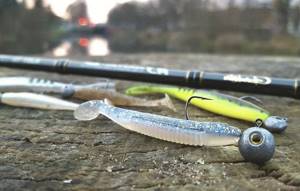
To do this, use a light, fast-action microjig rod 210-240 cm long with a sensitive glued-in tip of a bright color, 0.5-5 g test. Such a spinning rod is equipped with a small spinning reel measuring 1000-1500.
A thin braided cord with a cross section of 0.06-0.08 mm is used as equipment. Also suitable is monofilament with a thickness of 0.14-0.16 mm, a leash made of durable transparent fluorocarbon with a micro-fastener at the end.
The wiring technique for micro and nanojigs differs little from conventional jigs.
For lead rigs and wobblers, a stiffer and less sensitive fishing rod is used. It is better to take a test up to 15 grams.
In May
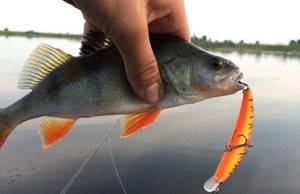
They catch it at this time near the coastline on the border of clear water and thickets of young reeds, coastal snags, flooded trees or bushes. In this case, more rigid spinning rods are suitable, not only classic jigging rods, but also twitching rods.
At this time, the pike also begins to actively bite. In places where it is found in large quantities, a thin tungsten leader is added to the equipment.
Best lures
The best bait option for catching perch in the spring would be:
- — twisters, vibrotails 2.5 to 7.5 centimeters long;
- — rotating spoons;
- - shad and minnow wobblers with a length of 5 to 7 centimeters.
Jigs help catch perch immediately after the ice melts. The fish is staying near the bottom at this time, and tapping it will give good results. In April-May, in the same places you can try to catch a larger predator using a heavy jig.
Rotating spoons vibrate strongly when retrieved and attract the attention of the striper. They are used from mid-April to the end of May for fishing at shallow depths. Wobblers are effective at any depth, with slow retrieval. It is necessary that the baits have colors that the perch will notice. For muddy water, bright, visible from afar spinners and wobblers are needed. In clear water, the predator is able to notice baits of natural colors.
Lures and Lures
In most cases, perches pay little attention to large baits. According to the experience of anglers, perch loves edible baits. In addition to slugs and silicone worms, you can include the following:
- Vibrating tails have an elongated shape with a perpendicular tail. The size of such bait does not exceed 10 cm;
- Crayfish are more suitable for fish that prefer crustaceans. This bait raises a muddy cloud at the bottom of the reservoir, thereby interest- ing the fish with its movements;
- Frogs are suitable not only for catching perch, but also for catfish. The bait twitches its legs and forces the predator to attack it. Unlike other edible baits, the frog has a hook on its back, thanks to which it can catch large fish.
Jigs and wobblers, as well as spinners, as mentioned earlier, perfectly complement the preferences of perch during spring fishing. In shallow water and shallow depths, they play well with stripers, which attracts them to rush and attack these baits.
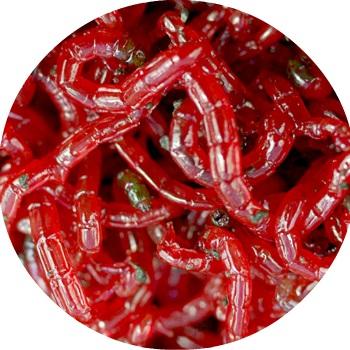
bloodworm

earthworms maggots
Spring baits are no different from the seasons. This may include such as:
- bloodworm;
- maggot;
- muckworm;
- larvae of various insects;
- crustaceans;
- canned food
Option for rigging live bait on a spinning rod
For example, a worm is recognized as a universal bait and is baited with a stocking, piercing its body in several places. This will make it flutter more often, attracting the attention of the fish.
Live bait works no less successfully. It is strung on both a single and a treble hook behind the dorsal fin. The most widely used live bait for perch is:
- bleak;
- gudgeon;
- crucian carp and other small fish.
If the live bait is larger, the cautious predator will not pay attention to the large bait and will swim past.
The influence of weather on fishing
For successful fishing, it is not enough to choose the right place for fishing and equipment. We must take into account:
- — presence of wind, precipitation;
- - Atmosphere pressure;
- — changes in the water level in reservoirs and the degree of its transparency.
The predator does not bite after floods and during high water caused by spring rains. The water becomes cloudy, and the perch cannot see anything in it. The activity of the striped fish is reduced by sudden changes in atmospheric pressure. A good bite can be expected with stable pressure, in sunny weather, on rainy but warm days when the southwest wind blows.
Fishing with bottom tackle
Another fairly catchy tackle at this time could be a donka with a rubber shock absorber; the advantage of such tackle is the number of hooks. If the perch bites well, you can pull out two or even three fish at a time. Using a donkey, you can use both a worm and a fry as a bait, although with a fry the bites are rarer, but the size of the fish that pecks is an order of magnitude larger.
And in conclusion, I would like to say that it doesn’t matter what gear you ultimately choose, the main thing is that catching perch in April will give you a lot of pleasure in any case.
Catching perch from the shore in spring
Hunting for perch from the shore in the spring using a spinning rod is not prohibited in many regions, even during spawning. But in its midst it is rarely successful. It is better to fish before and after spawning so as not to waste time. The following rules apply:
- 1. On small bodies of water you can use a spinning rod up to 2.1 meters long with a fast and ultra-fast action.
- 2. For long casts on spacious lakes, reservoirs, and wide rivers, you will need a rod up to 2.7 meters long.
- 3. If the forms have a medium action, they are used only with spinners.
It is advisable to fish from the shore in early and mid-spring on small rivers, ponds and lakes. At the end of April and May, a good catch can be in the coastal zone of large reservoirs.
You can recognize where the perch is by the splashes that appear when the predator is actively hunting for the fry. If there are any, you should throw the bait and make a leisurely retrieve. If they are not there, you need to walk along the shore and fish promising areas. If there are no bites, you need to change the bait and wiring method
Techniques for catching perch in May
In May, when striper feeding reaches its peak, perch fishing leaves a very vivid impression. At this time, they gather in large colonies and become a real disaster for small fish.
And quite easy prey for a spinner. In May, perch are caught in the middle and upper layers of water, often focusing on splashes during the hunt. If you notice an area of perch feeding, you should immediately throw the bait, ideally so that it lies further than the hunting school without scaring off the fish.
And pull the bait towards the school, near the surface or in a small depth. Most often, with such wiring, the perch grabs the “prey” and turns into it itself.
Thus, from one such site, it is sometimes possible to catch a large number of perches. Small “oscillators” and rotating spoons are excellent for this method of fishing.
Catching perch from a boat in spring
Fishing from a boat allows you to fish large areas of water and explore the supposed habitats of large specimens that do not approach the shore. From a boat you can cast on rivers up and downstream in the direction along the dump. A good option is to anchor close to the shore and move bait along the aquatic vegetation or from the coast to depth. In the latter case, you can catch not only an average perch, but also a respectable striper.
When can you fish?
You should start fishing after the water warms up to about 10 degrees. The perch scramble into schools and then go to spawn. The fish selects small, not deep, calm areas without current for spawning. Large individuals behave much more cautiously than small ones; they try to stay at a depth of at least four meters.
Spawning occurs in more than one stage, ending with spawning; the perch is in no hurry to leave this place. After sitting for a while and gaining strength, he begins the hunt for peaceful fish. By the end of April, perch begins to catch the hooks of experienced anglers.
Features of wiring, hooking and fishing
After the ice melts, the fish can be weak and lethargic. Therefore, the retrieves must be slow so that the perch has time to catch up with the bait. They become fast and sharp only from mid-May after the water has warmed up well. The striped whale becomes more active and begins to respond to such a game. Wherein:
- 1. Stepped retrieves are used when fishing with jig heads with silicone at depths of more than 2.5 meters. First, they cast, wait for the bait to fall to the bottom, and make two or three turns of the reel. Then they pause until the head falls to the bottom again. The process is repeated several times. If there is no bite, you should change the place.
- 2. Uniform retrieve is suitable for fishing with spinners in shallow water. They cast, let the bait lie on the bottom, lift the spoon with a sharp swing and smoothly reel in the line. The speed of its winding at the beginning of spring should be low. Closer to summer it increases.
- 3. Twitching jerk wiring is carried out with wobblers. The game is provided by the form. First, the bait is lowered into the water, then the whip is swung sharply so that the bait moves forward without jumping out of the water. Then the excess fishing line is reeled in and a sharp swing is made again. This method of wiring attracts sleepy perch.
Lure
It’s always good to have bait with you when fishing, even if you don’t have to use it. Bait can be useful to keep the fish near the hole if the need arises. Even a one-time toss may be quite enough for the entire time spent on the pond.
The best bait for perch is bloodworms. It can be either a small feed fish or a regular one, which is placed on a hook. There will be no difference. It’s just that the first option will be much cheaper in cost.
Bloodworms can be lowered into the hole without any additional additives, or you can mix it into the feeding mixture. Fishermen either make it themselves or buy a ready-made mixture at a fishing store. In both cases, it will be useful to crush the bloodworms a little before putting them in the water.
In addition to bloodworms, you can use maggots and worms. Worms can be lowered into the hole either whole or in crushed form. And all this can also be mixed into the finished feeding mixture.
At shallow depths there is no need to use a feeder. But at great depths, a feeder will be a better choice, especially if you need to deliver the bait to the bottom, and not to the middle layers of the water.
The designs of feeders are very diverse. There are both ready-made purchased ones and many home-made designs. Each fisherman prefers to use something of his own, what suits and likes him best.
Hooking and landing
Perch has weak lips, and to catch it, you need to hook it correctly. Do not jerk the rod after the fish has grabbed the bait. The lips will tear and the prey will escape. You need to hook gently, but distribute the force, focusing on the distance to the bait. The softer the blank, the greater the strength. This applies to perch of any size.
Fishing for small minke whales is carried out in the classical way. But with medium and large specimens there are difficulties. It happens that after hooking them it is difficult to move them. The fish resists, spreads its fins and puffs up. It is dangerous to force events in this case. The prey may bolt and get off the hook. It is necessary, slowly, to increase the tension of the cord and slowly bring the fish to the shore.
Lures for perch
A spinner or spinner is a very popular bait, often called a “perch”. When seeing it in motion, rarely does a minke whale remain indifferent.
When choosing a spinner, you need to take into account where you are going to fish, what size perch is caught in this water. So, for a larger perch , accordingly, larger tackle is selected (pre-spawning period is an exception); if it is a river, then a heavier tackle with narrowed petals weighing 5-10 grams is sometimes heavier; on a lake, a lighter spinner is suitable, with a wider petal weighing up to 6 grams.
Perch willingly attacks bait with red dots, or an additionally equipped red tassel. Here is a list of several recognized as the best perch lures:
- Mepps Aglia
- Mepps Comet Black Fury
- Blue Fox Super Vibrax
- Daiwa Silver Creek
- Myran Agat
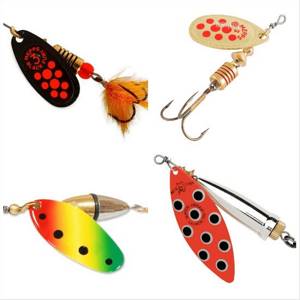
In addition to spinners, wobblers, twisters, and edible rubber bands are actively used in spring fishing . The advantage of the latter is that the perch, when chasing the bait, often does not immediately grab it, but begins to bite it, as it were.
If ordinary silicone scares away, then the “edible” one has a taste that will not leave the perch indifferent.
When fishing in overgrown areas where stripers often hunt, it is appropriate to use diluted bait with a twister.
A method when the weight is attached separately, above the twister, and the hook does not pierce the twister, but is on the same level with it.
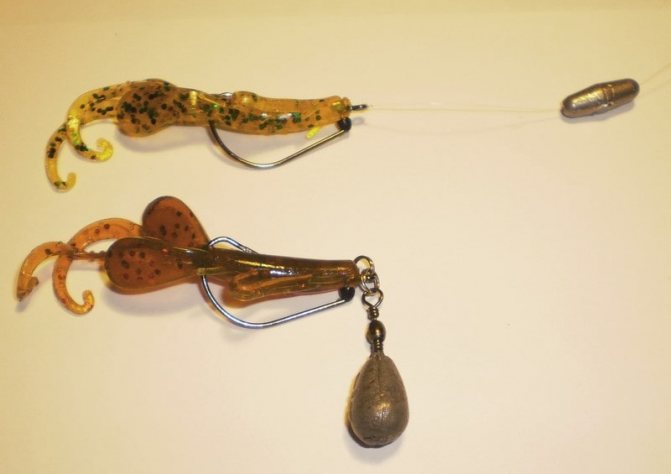
fastening method to avoid snags
This rigging method avoids inevitable snags. The bait slips through the thickets, and if a snag occurs, the silicone bait will not be harmed.
In any case, to successfully catch perch in spring water, you need to have a different set of gear and experiment with replacing bait and retrieving method.
Rotating and oscillating spoons
This group of lures is the least demanding both on the rod and on the skills of the fisherman himself; it is the spinners that are most often recommended to beginners in spinning fishing as the easiest to learn. If we talk about perch, it is better to fish with relatively small baits. In the case of rotating spoons, these are numbers from 00 to 2 according to the Mepps classification; it is also better to choose smaller spoons than those used for pike fishing - from 4 to 6 centimeters will be quite enough.
Very miniature trout spoons can sometimes show good results. It’s worth experimenting with the coloring of baits. Sometimes natural colors for spinners - silver, copper - are more effective, but in other cases, acid yellow or red models catch better.
Using different types and speeds of retrieve, you can fish with rotating and oscillating spoons on almost any horizon, which makes them universal baits suitable for any conditions.
Spring fishing with a spinning jig
Mormospinning is a fairly new and interesting direction in spinning fishing, which, however, will require slightly different gear. First of all, this concerns the fishing rod. Instead of the usual fast or super-fast blank for fishing in other ways, slow trout spinning rods or rock-fishing options with a soft glued tip and as little dough as possible are more suitable here.
Fishing with a spinning rod using a jig also places increased demands on the reel. A suitable inertia-free fishing rod must have a very smooth ride and ideal laying of ultra-thin cords, otherwise, instead of fishing, you will have to untangle the “beards”.
The leash in this type of fishing is most often made of relatively thick fluorocarbon, which additionally slows down the sinking of the jig to the bottom. The hook usually has either an artificial bloodworm or a cut of edible silicone damaged by predators on previous fishing trips. The wiring is also quite peculiar - sweeping swings of the rod with a minimum speed of winding the cord with the reel. Mormyshing is an extremely interesting trend in spinning fishing, as it allows you to catch not only the most passive perch in the most crowded reservoirs, but also different types of peaceful fish.
Behavior of perch in spring
In April, perch is unpredictable. Even experienced fishermen find it difficult to guess where and at what time of day it will bite. As a rule, the predator begins to spawn around the middle of the month and devotes 1.5 to 2 weeks to procreation. Before this, its activity varies and depends on the weather and conditions on the reservoir. Directly during the spawning period, the bite almost completely stops; you can only count on rare and weak bites. After spawning, the perch quickly recovers and begins to actively feed. It really fattens and is caught in large quantities. The spring post-spawning feast will not last long, so experienced fishermen are in a hurry to enjoy this happy moment.
Bass fishing can be ruined by muddy flood waters. Most often it becomes like this in April. When feeding, the striped robber relies mostly on its vision, but with low water transparency it becomes a poor helper. Therefore, the predator moves slowly and often passes by the bait. This is one of the main reasons for the poor bite in mid-spring.
Place and time of fishing
Since the water is still cold in April, perch prefers to stay at a comfortable depth of 2 to 4 meters. Only small minke whales come out into open shallow water, closer to coastal vegetation, and are of no interest to anglers. During this period, a flock of medium-sized individuals or a couple of large humpback whales can only be found in certain places. These include:
- stuck areas of the reservoir, the depth of which exceeds 2 meters;
- whirlpools at river bends;
- fairly deep places with a relief bottom (edges, holes, hills and other bottom anomalies);
- mouths of tributaries;
- areas remote from the shore covered with shell rock.
It is useless to look for perch on a flat muddy bottom; it avoids such places. It will also not be there where the spring flood has turned the water into pure turbidity. In order not to lose a lot of time later, you need to sacrifice a few minutes at the very beginning of fishing. Upon arrival at the reservoir, the first thing you need to do is look around carefully, identify promising points, and only then pick up the tackle.
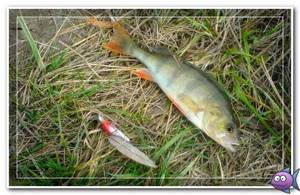
If the weather is warm and windless, the predator may start pecking in the early morning. The duration of the bite varies. On some reservoirs, the striped fish is active throughout the day, and in the evening its activity, as a rule, intensifies. On others, anglers observe only periodic short-term exits. In cold weather with strong winds, the chances of seeing a perch bite are close to zero, so experienced perch anglers stay home and patiently wait for more suitable weather conditions.
Peculiarities of fish behavior by season
This fish can be active at any time of the year, but the preferred hunting areas of perch can change significantly. This is primarily affected by water temperature. During the period that winter fishing enthusiasts call “the last ice,” as well as immediately after the complete disappearance of ice from rivers and ponds, this predator stays mainly at great depths, so catching perch with a jig in the spring is a suitable option.
As the water temperature rises, the striped predator leaves for spawning (which occurs at approximately 8 degrees), at this time you should not count on effective fishing.
Important! During spring floods, the activity of perch can significantly decrease, since during hunting this predator largely relies on vision, and turbid water interferes with active feeding.
After spawning, in already sufficiently warmed and brightened water, perch, especially small ones (larger individuals still stay closer to the riverbed and in greater depth), hunt more in shallow waters, sandbanks and along the growth line of reeds. At the same time, the so-called post-spawning glutton is often observed at this time.
